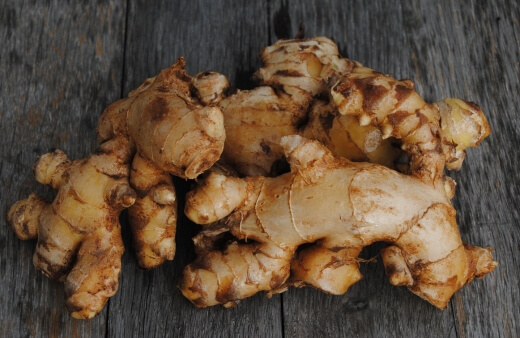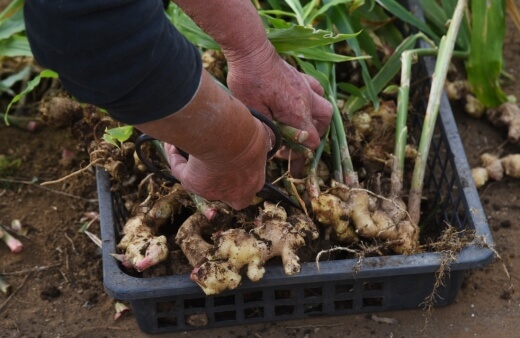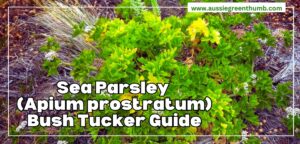Ginger, a root vegetable native to South Asia, is known for its pungent and spicy taste, as well as its numerous health benefits. As well as being a key ingredient in Asian, Indian, and Caribbean cuisine, it is also a stunningly beautiful flower for ornamental borders, making it an incredibly useful and multipurpose plant for any Australian garden.
While ginger is commonly found in supermarkets, growing your own ginger can be a fun and rewarding experience. In this ultimate growing guide, we will provide you with all the information you need to successfully grow ginger in your own garden.
More...

Family: | Zingiberaceae |
|---|---|
Genus: | Zingiber |
Species: | Z. officinale |
Origin: | Southeast Asia |
Common Names: | Ginger |
Location: | indoor or outdoor |
Type: | herbaceous perennial |
Growth: | 2-4 ft tall and wide |
Sun requirements: | Part shade to full sun |
Foliage Colour: | Green |
Flower Colour: | Yellow with purple tips |
Flowering: | Summer |
Fruits: | Red berries (edible but milder than the root, and the seeds should be avoided) |
Maintenance level: | Low |
Poisonous for pets: | Yes, can cause upset stomach and vomiting in cats and dogs |
What is Ginger and How Does it Grow?
Ginger (Zingiber officinale) is a tropical plant that belongs to the Zingiberaceae family, which also includes turmeric, cardamom, galangal, and our very own native turmeric and native ginger. Ginger is a perennial plant that grows up to 1 metre tall and has long, pointed leaves that can grow up to 20 cm in length.
The part of the plant that is usually eaten is the rhizome, which is a horizontal stem that grows underground, but you can actually eat the leaves, flowers and seeds, too. The rhizome, though, is the source of ginger's distinct flavour and aroma, as well as its health benefits.
Natural Habitat of Zingiber Officinale
Ginger is native to South Asia, specifically India, but it is now widely cultivated in other tropical regions such as Africa, the Caribbean, and Australia. In the wild, ginger grows in the understory of tropical rainforests, where it receives dappled sunlight and consistent rainfall, as well as the trapped humidity of the forest floor.
How to Grow Ginger in Australia
Ginger can be grown both indoors or outdoors, and is one of the few houseplants that is actually useful in the kitchen. However, for me, ginger will always be first and foremost a stunning and ornamental garden border perennial, adding vibrant colour to the garden in summer, and adding warmth to my cooking in winter.

Growing Ginger Indoors
If you want to grow ginger either as a houseplant, or in a greenhouse, you’ll need good ventilation, and a strong watering regimen.
- Choose a container: Ginger can be grown in a pot or a container that is at least 30 cm deep and has a diameter of 30cm or more. Make sure the container has drainage holes at the bottom to prevent waterlogging.
- Fill the container with potting soil: Use a well-draining potting mix that is rich in organic matter.
- Plant the ginger: Place a small piece of ginger rhizome (about 2-3 cm in size) with at least one bud facing upwards on the surface of the soil. Cover it with 2-3 cm of soil and water lightly.
- Water regularly: Keep the soil moist but not waterlogged, and avoid overwatering. Ginger needs consistent moisture to grow, especially during the growing season.
- Provide bright, indirect light: Ginger prefers bright, indirect light but can also tolerate some shade. Place the container in a well-lit area, away from direct sunlight.
- Fertilise the plant: Ginger can benefit from regular feeding with a balanced fertiliser during the growing season.
- Harvest the ginger: Ginger can be harvested after 8-10 months, once the leaves start to yellow and die back. Carefully dig up the rhizomes, cut off the edible portion, and replant the remaining rhizomes for future growth.
How to Grow Ginger Outdoors
You can plant ginger directly outdoors, or grow your rhizome in a pot first, before planting into the ground. However you choose to plant it though, the guide below should be followed for the best results.
- Choose a spot that receives partial shade: Ginger thrives in areas that receive partial shade or filtered sunlight. Direct sunlight can scorch the leaves and damage the roots.
- Prepare the soil: Ginger prefers well-draining soil that is rich in organic matter. If the soil in your garden is clay or sandy, add some compost or well-rotted manure to improve its fertility and drainage.
- Plant the ginger root: Dig a hole that is about 15-20 cm deep and 25-30 cm wide. Place the ginger root in the hole with the buds facing up and cover it with soil. Space the ginger roots at least 20-30 cm apart.
- Water the ginger regularly: Ginger requires regular watering, especially during the growing season. Keep the soil moist, but not waterlogged, to prevent root rot.
- Mulch the soil: Mulching can help retain moisture in the soil and prevent weeds from growing. Apply a layer of organic mulch, such as straw, leaves, or wood chips, around the ginger plants.
- Fertilise the ginger: Feed the ginger plants with a balanced fertiliser that is rich in nitrogen, phosphorus, and potassium. Apply the fertiliser every 4-6 weeks during the growing season.
- Control pests and diseases: Keep an eye out for pests such as aphids, mealybugs, and spider mites, which can damage the leaves and stems of ginger plants. Diseases such as bacterial wilt and root rot can also affect the plants. To prevent these problems, practise good hygiene, avoid overwatering, and remove any infected plants immediately.
- Harvest the ginger: Ginger takes about 8-10 months to mature. You can harvest it when the leaves start to yellow and die back. Gently dig up the rhizomes and remove the rootlets. Wash the ginger, dry it, and store it in a cool, dry place.
Overall, growing ginger outdoors in Australia can be a rewarding experience. With the right growing conditions and care, you can enjoy a bountiful harvest of fresh, aromatic ginger root.
How to Propagate Ginger

Propagating ginger from seed is possible, but it can be difficult and time-consuming. It's best to buy ginger rhizomes from a local nursery or trusted online supplier to ensure success. Ginger is typically propagated from root cuttings or rhizomes, which are sections of the underground stem that produce new growth.
To propagate ginger from root cuttings, select a healthy ginger root and cut it into 2-3 inch sections. Make sure each section has at least one growing bud. Plant the sections about 2 inches deep in a well-draining potting mix or directly into the ground if you live in a warm climate. Keep the soil moist, and new growth should emerge within a few weeks.
Another method for propagating ginger is to use a piece of ginger from the grocery store. Look for a fresh ginger root with several knobs, which are the growing buds. Soak the ginger root in warm water overnight to soften it. Cut the ginger into 1-inch pieces, making sure each piece has a growing bud. Plant the ginger pieces about 2 inches deep in a potting mix, and keep the soil moist. New growth should appear within a few weeks.
Caring for Ginger Plants
Ginger plants are relatively easy to care for, but they do require regular watering and fertilising to grow well. Here are some tips for caring for ginger plants:

Mulching and feeding ginger plants
Mulch around the base of the ginger plant with organic matter such as compost, shredded leaves, or straw. This will help keep the soil moist and suppress weeds. As well as mulching, remember that ginger is a hungry plant, particularly if you want it to perform well in flower, and flavour. Fertilise ginger plants every 2-3 months with a balanced organic fertiliser. I always use liquid seaweed for this.


Get Your Free Guide:
Master Growing Australian Natives eBook
A Must Have Complete Guide for Every Australian Garden
Get Your Free Guide:
Master Growing Australian Natives eBook
A Must Have Complete Guide for Every Australian Garden
How often to water
Ginger plants require consistent moisture, but they don't like to be waterlogged. Water your ginger plant regularly, keeping the soil moist but not waterlogged. In hot weather or if you're growing ginger indoors, you may need to water more frequently.
When to repot
Ginger plants can become rootbound over time and may need to be repotted. Look for roots growing out of the drainage holes as a sign that it's time to repot. Choose a pot that's slightly larger than the current one and fill it with fresh potting soil. Gently remove the ginger plant from its old pot and plant it in the new pot at the same depth.
Caring for ginger over winter
In cooler climates, ginger plants will need protection from frost. If you're growing ginger in a pot, bring it indoors when temperatures drop below 10°C. If you're growing ginger in the ground, cover the plants with a layer of mulch or horticultural fleece to protect them from cold weather over winter.
Harvesting Ginger

Ginger is typically ready to harvest about 8-10 months after planting. Look for yellowing leaves as a sign that the ginger is mature. To harvest, carefully dig up the entire plant, being careful not to damage the ginger rhizomes. Rinse the rhizomes in cool water and store them in a cool, dry place.
How to Store Ginger
Ginger can be stored for several weeks in the refrigerator or several months in the freezer, which will retain its flavour better than any other method, but it will also begin the deterioration of the rhizome faster thanks to higher humidity.
If you don't mind your ginger’s flavour being slightly depleted, you can store ginger in a cool, dark, and dry cupboard for up to six months, which will allow you to replant it next year, or use it right the way through winter.
Possible Ginger Pests and Diseases to Look Out For
If you notice any signs of pests or disease on your ginger plants, act quickly to prevent the problem from getting worse. Remove infected leaves or stems and dispose of them away from your garden to prevent further spread. You may also need to use an appropriate pesticide or fungicide to control the problem.
Aphids
These small insects can suck the sap from the leaves and stems of the ginger plant, causing the leaves to turn yellow and curl. They can also transmit viruses from plant to plant.
Check out our guide on how to get rid of aphids and find out how to prevent them from coming back.
Spider mites
These tiny pests can cause yellow or white speckling on the leaves of the ginger plant. They are difficult to see with the naked eye, but you may notice fine webbing on the plant.
For more info, check out our in-depth guide on how to get rid of spider mites.
Mealybugs
Mealybugs can cause the ginger plant to appear stunted or deformed, and the leaves may appear to be covered in white, fluffy material.
Root knot nematodes
Root knot nematodes are a nightmare for ginger growers, as they can cause the roots of the ginger plant to become swollen and deformed, and the leaves may wilt and yellow. They are difficult to control once established.
Pythium rot
This fungal disease can cause the roots of the ginger plant to rot, and the leaves may wilt and turn yellow. The plant may eventually die if left untreated.
Bacterial wilt
This disease can cause the leaves of the ginger plant to wilt and turn yellow, and the stem may become soft and mushy. The plant may eventually die if left untreated.
Fusarium wilt
This fungal disease can cause the leaves of the ginger plant to wilt and turn yellow, and the stem may become soft and mushy. The plant may eventually die if left untreated.
Yellowing disease
This viral disease can cause the leaves of the ginger plant to turn yellow and the plant may become stunted. There is no cure for this disease, so infected plants should be removed and destroyed to prevent further spread.
Frequently Asked Questions About Growing Ginger

Can I grow ginger from the grocery store?
You can grow ginger from a store-bought rhizome. Look for a plump, firm rhizome with several small eyes (or buds). Soak the rhizome overnight in water, then plant it in a pot or in the ground with the buds facing up.
How often should I water my ginger plant?
Ginger plants prefer slightly moist soil, but they do not like to be waterlogged. Water your ginger plant when the top inch of soil feels dry to the touch.
Wrapping Up Our Ginger Growing Guide
Whether grown indoors or outdoors, ginger plants can add both beauty and flavour to any garden or kitchen. By choosing the right location and soil, and taking a bit of care with watering and feeding, you can grow ginger in Australia and enjoy its unique taste and health benefits.
Propagating ginger from seed or root cuttings can also be a fun and cost-effective way to expand your ginger collection, and is a great garden experiment for kids. Keep an eye out for potential pests and diseases, but with proper care, your ginger plants should thrive.
With this ultimate growing guide, you can confidently start your own ginger growing journey and enjoy the rewards of fresh, homegrown ginger.
Published on May 28, 2023 by Maisie Blevins
Last Updated on September 19, 2024




